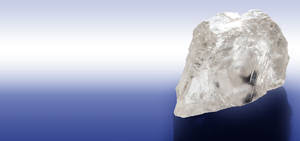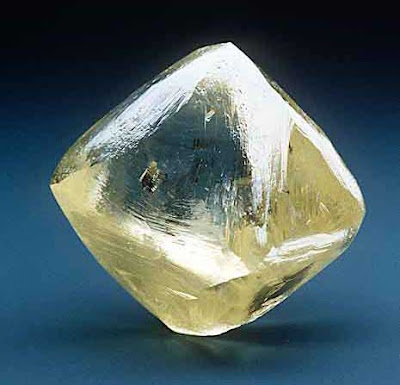
Investing in a mine that De Beers decided to cast off would seem to many a risky consideration, especially for a junior miner. However, when the opportunity arose in 2008, South Africa-based Petra
Diamonds saw an opportunity to score big.
And it certainly did. In the space of little more than a year, Petra’s new acquisition yielded the 507-carat Cullinan Heritage, which was classified as virtually flawless and went on record as the 19th largest
diamond ever mined. It was sold to a jeweller in Hong Kong for $35.3 million, the highest-ever sale price achieved for a rough diamond. That stone alone helped boost the company’s revenues by 88 percent in the 12 months to June 2009.
Granted that this was no ordinary mine. The Cullinan Mine, which Petra purchased from De Beers in 2008 began life in 1902 as the Premier Mine, outside the town of Cullinan, 40 kilometres east of the South African capital of Pretoria. In 1905, it produced the world’s largest diamond and one of the most famous, the 3,016-carat Cullinan. Since then, the mine has produced a quarter of all diamonds weighing more than 400 carats, and four of the top 20 largest high-quality gem diamonds: the Cullinan, weighing 3,106 carats; the Golden Jubilee, at 755 carats; the Centenary at 599 carats; and the 507-carat Cullinan Heritage.
Indeed, the Cullinan Heritage is just one of many exceptional white diamonds Petra has extracted in the past year from the Cullinan mine. In addition, there was a 168-carat that it sold for $6.3 million, a 64-carat diamond sold for $3.7 million, two 50+ carat stones sold for $2.8 million, a 104-carat diamond sold for $2.0 million, and a 37-carat diamond sold for $1.1 million.
Cullinan’s rare blue diamonds also command high per carat prices, with a 6.7-carat blue sold for $510,000, and a 6.5-carat blue manufactured to a 2.8-carat polished stone sold for $250,000. Meanwhile, at Petra’s Koffiefontein mine, a 70-carat diamond was sold for $1.1 million, and a 34-carat gem sold for $1 million.
Earlier this month, it was announced Petra has completed a transaction for loan facilities of $83.5 million, which means it will be able to finance the expansion of the Cullinan mine, as well as the Williamson mine in Tanzania in which it has a 75-percent stake.
Cullinan contains the world’s second-largest indicated
diamond resource, of 181.4 million carats, included in a total resource base of 203.3 million carats (including tailings), and the company is planning an expansion programme at the mine to take annual production from just over 920,000 carats in full year 2010, to 2.4 million carats by full year 2019. This expansion plan will eventually access the first portions of the major C-Cut resource, which is estimated to contain some 133 million carats, and will also involve a large tailings operation.
Petra Diamonds was established in 2005 when the firm, which was then just a pre-production diamond explorer with assets in Angola, merged with Crown Diamonds, a miner with projects in Sierra Leone. Shortly afterwards, De Beers was under pressure to sell assets and was looking to offload part of its holding in Cullinan, which was producing fewer of the huge stones for which it had become famous. Petra bought a 37 percent holding, which it has since increased to 74 percent.
Although acquiring a mine that had been in operation since 1902 might be considered by some as something of a risk, Petra Diamonds carried out a great deal of due diligence before going ahead with its first acquisition of 37 percent, said Bobby Morse, a Cullinan spokesperson. “There was a lot of confidence that it was a good acquisition because Cullinan has always produced good levels of diamonds, and many large high-quality diamonds. Petra is good at right-sizing operations; it’s much easier to take on a mine of this type when you are a company of the size of Petra,” Morse said.
Morse said it was common in a range of mining industries for larger producers to sell off smaller operations since a point is reached when it may not be economically worthwhile to carry on running. “De Beers is a very big company that has much larger mines with which to occupy itself and where they may prefer to put their capital.
“Cullinan is part of the so-called C-Cut which requires an investment of some tens of millions of dollars and a miner like De Beers may prefer to use that money on its larger operations rather than spending that capital on a mine whose output might be marginal to their overall operations. It makes sense for De Beers to receive money for selling its share in Cullinan and not to have to invest money in expanding the mine,” Morse said. That principle was applied by De Beers at several of its operations since it also sold its Kimberley Underground and Koffiefontein mines in South Africa, and its share in the Williamson mine in Tanzania.
“For Petra Diamonds, the aim is to achieve annual output of three million carats by 2019,” Morse said. “That is their aim, and they have the assets to get there because they have several mines not just one mine as is the case with many junior miners. Petra has high-level, experienced people, with some of them having worked for De Beers.”
Morse said that while acquisitions was not a core part of its strategy, if it considered that a deal could be beneficial to its shareholders then it would be willing to do so. “It is not a core part of its model – which is to treble production – but don’t be surprised if it did so if there was an acquisition that is accretive.”
Petra Diamonds sees its investment in Petra, and its other mines, as a success. It has interests in seven producing mines: six in South Africa – Koffiefontein, Kimberley Underground, Helam, Sedibeng and Star, in addition to Cullinan, and the Williamson mine. The company reported a turnover of $17 million which soared to gross revenue of $177.7 million for the year ended June 30, 2010, and was up 88 percent on the year-earlier period, while it also recorded net profit of $70 million. Petra says it is on track to more than double diamond production to 2.5 million carats by 2014 – and triple production to more than 3 million carats by 2019. For the year ended June 30, gross diamond production rose 6 percent to 1.16 million carats.
Petra Diamonds has raised its expectations for the long-term potential at its Cullinan, Williamson, Kimberley Underground and Koffiefontein mines, both in terms of output and prices. There could be a possible decline in prices only if release of stockpiles of diamonds from Russia or Zimbabwe. The company also faces a handicap from currency issues as the South African rand remains strong and the dollar continues to decline.
Although Petra Diamonds is mainly concerned with raising production, it is also carrying out exploration. The group’s “modest annual exploration budget” is now focused on Botswana, which also offers a friendly operating environment.
Looking forward, Petra Diamonds says it has witnessed an upturn in the important U.S. market, “as evidenced by the steadily increasing volume and value of polished diamond imports in 2010 and improved sales in North America reported by leading diamond retailers. As the diamond market now enters the pre-festive season, expectations are for a continued improvement that should end with robust retail sales in the fourth quarter.”
For the 2011 financial year, it foresees diamond prices being firmer as long as the market and global economy remain stable. “Cullinan is our flagship asset and, along with Williamson, a key driver to Petra’s production and revenue growth in the coming years,” said Petra Diamonds' CEO Johann Dippenaar in an interview with The Independent.
“We completed the acquisition of the Kimberley Underground mine in the past year and introduced a seventh producing diamond mine to our portfolio. We had been operating Kimberley Underground on a care and maintenance basis together with De Beers since September 2007 and therefore had time to significantly rehabilitate the underground workings and to build the first of two new plants. Production has now commenced and the mine will be a valuable contributor to the company’s growth plans in the 2011 financial year,” Dippenaar added.
As for its sales and marketing operations, Petra’s management believes that as demand for rough goods grows stronger, there is a continuing constriction of the traditional diamond pipeline, with more and more companies opting for vertical integration.
“From Petra’s perspective, this is particularly evident by the number of major manufacturers and retailers now buying rough diamonds directly from the group’s tenders, rather than via traditional diamond traders,” the company said in its financial statement for full year 2009. “We think this trend will continue as rough becomes ever more scarce and our strategy to continue increasing output ensures that we are poised to benefit from this trend.”
http://www.antwerpfacetsonline.be/articles/single/article/purchase-of-de-beers-cast-off-pays-back-big-time/?tx_msgnewslettertracking_pi2%5Breferer%5D=antwerpfacetsnewsletter&cHash=1906dbf1dd1f2a6dbf1f570b5f90716a






